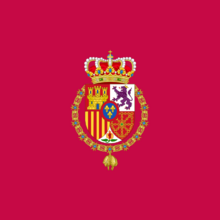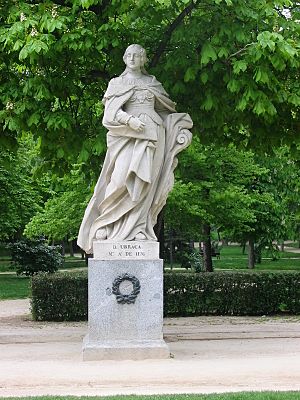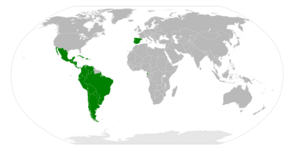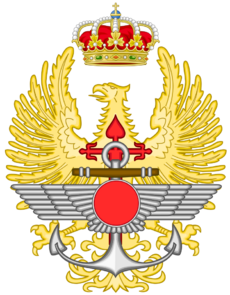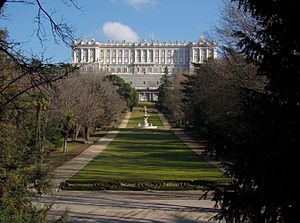Monarchy of Spain facts for kids
Quick facts for kids King of Spain |
|
|---|---|
| Spanish: Rey de España | |
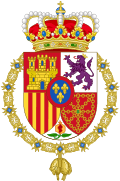
|
|
| Incumbent | |
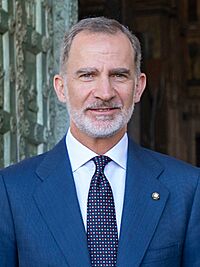 |
|
| Felipe VI since 19 June 2014 |
|
| Details | |
| Style | His Majesty |
| Heir presumptive | Leonor, Princess of Asturias |
| First monarch | Isabella I of Castile and Ferdinand II of Aragon (Catholic Monarchs of Spain) |
| Residence | Royal Palace of Madrid (official) Palace of Zarzuela (private) |
| Website | The Spanish Monarchy |
The monarchy of Spain is Spain's way of government. It means that a king or queen is the head of state. This role is passed down through the family.
The Spanish monarchy is also called The Crown (Spanish: La Corona). It includes the current ruler, King Felipe VI, his family, and the Royal Household. The Royal Household is a team that helps the King with his duties.
Today, the royal family includes King Felipe VI, Queen Letizia, their daughters Leonor, Princess of Asturias and Infanta Sofía, and the King's parents, King Juan Carlos I and Queen Sofía.
After a time without a king, the Spanish Constitution of 1978 brought back the monarchy. This happened when Spain became a democracy again in 1977. The Constitution says the King represents Spain's unity and lasting presence. He also helps keep Spanish institutions working smoothly. The King is the head of state and the commander-in-chief of the Spanish Armed Forces. The Constitution explains how the King gets his title, how the next ruler is chosen, and what powers the King has. The King also helps Spain connect with countries that share its history. He is the honorary president of the Organization of Ibero-American States. This group includes over 700 million people in 24 countries.
Contents
History of the Spanish Monarchy
The idea of a king or queen in Spain started a long time ago. It began with the Visigothic Kingdom and later Christian kingdoms like Navarre, Asturias, and Aragon. These kingdoms fought to take back the Iberian Peninsula from Muslim rule in a period called the Reconquista.
One important family was the House of Jiménez in the 11th century. They united much of Christian Iberia. Later, Alfonso VII of León and Castile was a powerful ruler. He divided his lands among his sons. A civil war in Castile (1366-1369) led to the House of Trastámara ruling.
The Catholic Monarchs Unite Spain
In the 15th century, something very important happened. Isabella I of Castile and Ferdinand II of Aragon got married. They were both from the House of Trastámara. This marriage joined two big kingdoms in Spain. They were known as the Catholic Monarchs.
In 1492, the Catholic Monarchs conquered the Kingdom of Granada. This was the last Muslim territory in Spain. This year is often seen as the start of a united Spain.
Spain also began to explore and settle new lands overseas. These new lands became part of the Crown of Castile. The Spanish Crown set up special courts and viceroys (like vice-kings) to rule these new territories.
The Habsburg Family Rules Spain
In 1505, the Spanish throne went to the House of Habsburg. This happened when King Charles I became ruler. He was the son of Queen Joanna and King Philip I of Castile. When Ferdinand II of Aragon died in 1516, Charles also gained the Aragonese lands.
Charles I ruled alone, even though his mother Joanna was still alive. After her death in 1555, he was clearly the only ruler. His son, Philip II of Spain, became king in 1556. From his time, people usually called the ruler the "King of Spain."
Philip II's reign was a golden age for Spain. It was a time of great colonial expansion and trade. The Spanish Crown controlled and profited from its overseas colonies. The death of Charles II in 1700, who had no children, led to a big war. This war was about who would be the next king.
The Bourbon Family Takes the Throne
After Charles II died, many people wanted to be the next king. Charles II had chosen Philip of France, the Duke of Anjou. But other European countries worried that Spain and France would become too powerful together. This led to the Spanish War of Succession in the 18th century.
The war ended with treaties that kept a balance of power in Europe. Philip V became the first ruler from the House of Bourbon in Spain. This family still rules Spain today with King Felipe VI.
In the 18th century, especially under Charles III of Spain, the Spanish Crown made big changes. These changes, called the Bourbon Reforms, aimed to improve how Spain and its empire were managed. They also wanted to get more money from the overseas empire.
During the Napoleonic Wars, the French Emperor Napoleon Bonaparte forced Ferdinand VII to step down in 1808. The Bourbons then became a symbol of resistance against French rule. However, Ferdinand's later actions made him less popular. He brought back an old law that allowed women to become queens. This meant his daughter Isabella could inherit the throne.
First Spanish Republic
In September 1873, Spain became a republic for a short time. This was called the First Spanish Republic. But a few years later, the Bourbon family was brought back to the throne in 1874.
Second Spanish Republic and Franco's Rule
In 1931, elections showed that many people wanted to end the monarchy and have a republic. Alfonso XIII left Spain, but he did not officially give up his title. This led to the Second Spanish Republic. The Spanish Civil War started in 1936 and ended in 1939. General Francisco Franco and his allies won the war.
After 16 years without a king, General Franco declared Spain a kingdom again in 1947. He ruled as the "Head of state of the Kingdom of Spain" until his death in 1975.
The Monarchy Returns
Even though Franco had allied with some groups who wanted a different king, he chose Juan Carlos de Borbón as his successor. Juan Carlos is known for helping Spain become a democracy after Franco's rule.
King Juan Carlos wanted faster democratic changes. He appointed Adolfo Suárez as President of the Government in 1977. The next year, the King signed the new democratic Constitution of Spain. Most voters approved it. In 1981, King Juan Carlos famously stopped an attempted military coup. He used his strong leadership to tell the military to stand down.
After 1981, King Juan Carlos focused on making sure the government worked well. He emphasized following the Constitution and representing Spain at home and abroad. He aimed to keep the monarchy neutral in politics.
The Crown, Constitution, and Royal Powers
The Crown of Spain is mentioned in the Spanish Constitution of 1978. It says the monarch represents Spain's unity and lasting presence. The King is also seen as the "Father of the Nation." In 2010, King Juan Carlos helped bring Spain's political parties together to deal with the country's economic problems.
The Spanish Constitution says that power comes from the people. This means the people give the King the power to rule.
The King helps guide how the government works. He also represents Spain in international relations, especially with countries that share Spain's history. The King carries out duties given to him by the Constitution and laws.
When a new King takes the throne, he makes an oath. He promises to follow his duties, obey the Constitution and laws, and respect the rights of Spanish citizens. The heir to the throne, the Prince of Asturias, takes a similar oath when he becomes an adult.
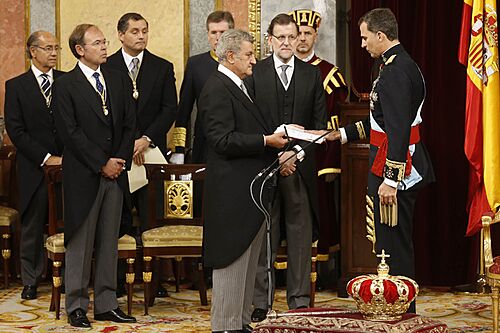
The 1978 Constitution explains the King's powers. It also defines his role in choosing the prime minister and forming the government. The King also has a role in Spain's independent court system. However, by tradition, the King makes his decisions after getting advice from the government. He tries to keep the monarchy neutral and independent. The King's actions must be approved by a minister to be valid.
The King's duties include:
- Approving and publishing laws.
- Calling and ending meetings of the Cortes Generales (Parliament) and calling for elections.
- Calling for a public vote (referendum) when the Constitution allows.
- Suggesting a candidate for President of the Government (Prime Minister) and appointing or removing them.
- Appointing and dismissing government members based on the Prime Minister's suggestion.
- Issuing decrees, giving civil and military jobs, honors, and awards.
- Being informed about state matters and sometimes leading Council of Ministers meetings.
- Being the supreme commander of the Spanish Armed Forces.
- Using the right to grant mercy (clemency) according to the law.
- Supporting Royal Academies.
Titles and Honors
The 1978 Constitution says the monarch's main title is King of Spain. But the King can also use other historical titles.
The King and Queen are called "His Majesty and Her Majesty." The husband of a Queen (Prince Consort) is called "His Royal Highness." Former kings and queens keep their titles after stepping down. The heir to the throne is called the Prince of Asturias. This title comes with other historical titles like Prince of Viana and Prince of Girona. Other children of the King are called Infante or Infanta (prince or princess) and are styled His or Her Royal Highness.
After he stepped down in 2014, Juan Carlos I and his wife Sofía are still called King and Queen of Spain.
The King gives out honors and awards in Spain. These include noble titles and military decorations. The Order of the Golden Fleece is the highest honor the King can give. Other important awards include the Order of Charles III and the Laureate Cross of Saint Ferdinand (for military bravery).
Protection of the King
The King of Spain cannot be charged in court for actions done by government ministers in his name. His actions are only valid if a minister approves them. This minister then takes responsibility. This is a common rule in constitutional monarchies. The King himself cannot be sued in any Spanish court. This protection only applies to the current King. It does not apply to other members of the royal family. When Juan Carlos I stepped down, he lost this special protection. However, a special law was passed so he could only be tried by Spain's Supreme Court.
There are also laws against insulting the King or the Spanish State. This is called lèse-majesté. Breaking these laws can lead to fines or even prison time. This concept is similar to laws against disrespecting a country's flag.
Who Inherits the Throne?
The Crown of Spain is passed down through the family of King Juan Carlos I. The oldest child inherits the throne. If there are sons, the oldest son inherits before any daughters. If there are only daughters, the oldest daughter inherits. This system is called male preference primogeniture.
This system has been used in Spain for a long time. However, there has been talk about changing the law so that the first-born child inherits, no matter if they are a boy or a girl. This is called absolute primogeniture. This discussion became more important when King Felipe VI's first daughter, Infanta Leonor, was born in 2005. Changing this law would require a complex process involving Parliament and a public vote.
If there are no more heirs in the royal family, the Parliament can decide who will be the next ruler. Members of the royal family can lose their right to the throne if they marry without the King's and Parliament's permission.
The current heirs to King Felipe VI are:
- The Princess of Asturias (King's elder daughter)
- The Infanta Sofía (King's younger daughter)
- The Infanta Elena, Duchess of Lugo (King Juan Carlos I's elder daughter)
- Felipe Juan Froilán de Marichalar y de Borbón (Infanta Elena's son)
- Victoria Federica de Marichalar y de Borbón (Infanta Elena's daughter)
- The Infanta Cristina (King Juan Carlos I's younger daughter)
- Juan Urdangarín y de Borbón (Infanta Cristina's eldest son)
- Pablo Urdangarín y de Borbón (Infanta Cristina's middle son)
- Miguel Urdangarín y de Borbón (Infanta Cristina's youngest son)
- Irene Urdangarín y de Borbón (Infanta Cristina's daughter)
If the King is too young or unable to rule, a regency is set up. The Regent rules until the King is old enough or able to rule again. The Regent must be Spanish.
The King, Government, and Parliament
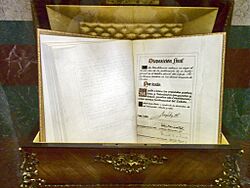
The government is made up of the President of the Government and other ministers. They handle Spain's policies, manage the military, and defend the nation, all in the King's name. The King's most direct power in forming a government is choosing and appointing the Prime Minister.
After an election, the King meets with leaders of political parties. He then talks with the Speaker of the Congress. The King then suggests a candidate for Prime Minister.
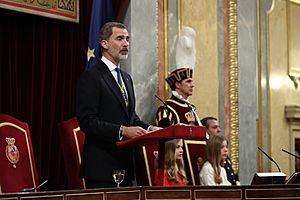
The King usually chooses the leader of the party with the most seats in Parliament. This shows the King supports the democratic process. The chosen candidate then presents their plans to Parliament. Parliament votes to approve the candidate and their plans. If approved, the King officially appoints them as Prime Minister.
If no candidate gets enough votes, the King suggests a new one. If no one can form a government within two months, the King can dissolve Parliament and call for new elections.
The King also meets weekly with the Prime Minister to stay informed. He sometimes attends cabinet meetings to hear directly from ministers about important national and international issues.
Governments usually serve for four years. After that, the Prime Minister resigns and advises the King to call new elections. The King can also dissolve Parliament if the Prime Minister doesn't ask for it after four years. If the government loses the support of Parliament, it must resign.
Royal Approval of Laws and the Justice System
The King approves and publishes new laws. After Parliament passes a bill, the King must approve it and publish it within 15 days. The King can also call for a public vote (referendum) if the Prime Minister advises it and Parliament agrees.
The Constitution does not directly say the King can stop a law. However, the King must give his approval for a law to become official. In 2005, when asked if he would approve a law allowing same-sex marriage, King Juan Carlos said, "I am the King of Spain, not of Belgium." This was a reference to a Belgian king who refused to sign a law.
Justice in Spain is carried out in the King's name by judges. The King appoints members to Spain's Supreme Court. He also appoints the head of the Supreme Court. These appointments are usually made with the government's advice. The King can also grant mercy, but he cannot pardon government ministers found guilty of serious crimes.
The King and International Relations
The King officially welcomes foreign ambassadors to Spain and sends Spanish ambassadors abroad. However, the government handles the details of foreign policy. The King also officially agrees to international agreements and treaties.
During his reign, King Juan Carlos greatly improved Spain's standing in the world. He helped Spain join the European Community and NATO. He also improved relations with the Vatican. The King was given the Charlemagne Award in 1982 for his work for democracy and European unity. The Constitution gives the King a special role in promoting relations with countries that were once part of the Spanish Empire, as well as Portugal and Brazil. The King of Spain is the president of the Ibero-American States Organization.
The King is helped by the Foreign Ministry in his diplomatic work. Other members of the royal family, like the Princess of Asturias, also represent Spain internationally. The King's speeches are carefully planned with the government to ensure a unified message.
The King and royal family members have visited many countries around the world. They have also spoken at international organizations like the United Nations and the European Union.
The King as Commander-in-Chief
The King is the supreme commander of the Spanish Armed Forces. This role is based on tradition and patriotism. The Constitution of 1978 and other laws define the King's role in the military.
However, the Prime Minister and the Minister of Defence manage the armed forces and defense policy. They are civil officers chosen by the King and approved by Parliament.
The King holds the highest military rank: Captain General of the Army, Navy, and Air and Space Force. He is the only officer with this 5-star rank. The King takes a strong interest in military matters. Serving in the armed forces is expected for the heir to the throne. Both King Juan Carlos and King Felipe VI served in the military before becoming kings.

The Monarchy Today
Public Opinion
Before the financial crisis in 2008, the monarchy was very popular in Spain. Many people supported it since it was brought back in 1978. King Juan Carlos often had approval ratings over 70%. People believed he played a key role in keeping Spain a democracy.
However, during the financial crisis, the monarchy faced more criticism. Some events caused public concern. For example, a controversial hunting trip by the King in 2012 led to public debate. The King later apologized, saying he made a mistake.
To regain public trust, the King took steps like publishing the monarchy's budget. In 2012, the King and the Prince of Asturias also took a pay cut to show solidarity with government officials.
Public opinion on the monarchy has become more divided in recent years. Some polls show a close split between those who support the monarchy and those who prefer a republic.
King Juan Carlos I's reputation also faced challenges due to concerns about past business deals. Since August 2020, he has been living outside Spain. In 2021, there was a controversy when King Felipe's sisters traveled to the United Arab Emirates to receive a vaccine.
Charity and Culture
Members of the royal family often become patrons of charities, cultural groups, or religious organizations. This gives these groups official recognition and helps them get public attention and raise money.
King Felipe, when he was Prince, led the Prince of Asturias Foundation. This foundation promotes science, culture, and human values. It gives out annual Prince of Asturias Awards to people and groups who achieve great things.
Queen Sofía dedicates much of her time to the Queen Sofía Foundation. This charity helps people from different backgrounds. Other members of the royal family also support various causes, from social welfare to disabled sailing.
King Juan Carlos started a tradition of giving annual Christmas Eve National Speeches. In these speeches, he talks about challenges facing the nation and shares messages of goodwill.
The Royal Household
The Royal Household (La Casa de Su Majestad el Rey) is the organization that supports the King and royal family. It helps them carry out their duties. The government provides money for the Royal Household each year. The Royal Household works with government ministries but is not part of the government itself.
The Royal Household is managed by the Head of the Household. This person oversees all operations. There are different departments, including those for the King, Queen, security, communication, and administration.
The Head of the Military Chamber helps with royal military events and ceremonies. This person is a high-ranking military officer. The King also has personal assistants called aides-de-camp from all branches of the armed forces.
The Royal Household has a public relations department. It manages the official website, Casa de S.M. El Rey. This website shares information about the royal family, their activities, speeches, and upcoming events.
Royal Homes and Sites
The King and Queen often hold official events at the Oriente Palace in Madrid. However, King Felipe, Queen Letizia, and their daughters live in a home called the Pavilion on the El Pardo estate. King Juan Carlos and Queen Sofía live at the Zarzuela Palace, also on the El Pardo estate. The El Pardo Palace itself is used as a guest house for visiting heads of state.
The Oriente Palace and the El Pardo palaces are part of the "Spanish royal sites." These are palaces, monasteries, and convents built for the royal family throughout history. They are owned by the state and managed by the Patrimonio Nacional (National Heritage). When the royal family is not using them, these sites are open to the public.
The royal family also spends holidays on the island of Palma de Mallorca, often at the Marivent Palace. King Juan Carlos, who enjoyed sailing, was given a yacht called the Fortuna. This yacht is also owned by the state.
Budget and Taxes
The King receives money from the yearly state budget to support his family and the Royal Household. This money helps the King carry out his duties independently and with dignity. The budget covers salaries for staff and general office expenses. The salaries for senior staff are similar to those of government ministers. The budget also pays for the expenses of senior royal family members who perform royal duties, such as clothing and groceries.
In 2010, the budget for the monarchy was about 7.4 million euros. In 2011, a report showed that only a small part of the budget goes directly to royal family members as salaries. Most of it covers the Royal Household's operating costs. In 2012, the monarchy voluntarily took a 7% pay cut.
The maintenance of the royal sites is not included in the annual budget. These sites are owned by the state and managed by Patrimonio Nacional. All members of the royal family pay taxes like other citizens.
See also
 In Spanish: Monarquía Española para niños
In Spanish: Monarquía Española para niños
- List of Spanish monarchs
- List of Spanish consorts
- Line of succession to the Spanish throne
- Carlism
- Republicanism in Spain
- Contemporary history of Spain
External links
- Centro de Investigaciones Sociológicas
- National Heritage official website: http://www.patrimonionacional.es/
la:Monarchia Hispanica



